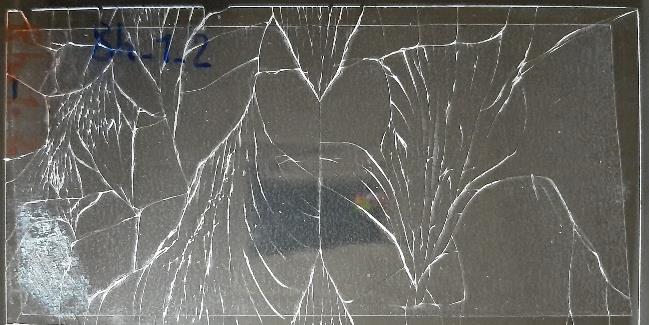Experimental Strength Characterisation of Thin Chemically Pre-Stressed Glass Based on Laser-Induced Flaws

Abstract
The strength of chemically pre-stressed glass depends on the depth of surface flaws and the value of the pre-stress. So far, some research has been conducted on this topic; however, there were always uncertainties regarding the flaw depth and the pre-stress profile. Consequently, this research characterises the pre-stress profile using experimental methods. The latter include measuring the depth of layer (DoL) and the surface compressive pre-stress (CS) with FSM-7000 h and verifying the achieved DoL with the Na+ and K+ distribution through the thickness obtained from the SEM/EDS analysis. Results demonstrate that the amount of K decreases parabolically (second-order) to a certain value and then remains constant. Based on this observation and some boundary conditions, the equation of the pre-stress profile was obtained for thin chemically pre-stressed aluminosilicate glass (Falcon®) with 8 h and 24 h processing durations in molten salt at 460 °C. A non-strengthened glass (NSG) was also used as a reference for comparison. Then, three artificial laser-induced flaws with accurately controlled depths is tested by means of a clamp bender. The results of the strength tests demonstrated very low deviations in the failure stress. It was shown that even when the depth of the flaw is higher than the DoL, which means that the flaw tip enters the zone with the pre-tensile stress, there is still considerable resistance from the surrounding intact area. Furthermore, it was confirmed that the pre-stress strain energy for 24 h processing is larger than for 8 h, leading to more fragmentation after failure under a similar loading condition. Finally, it was found that the fracture toughness is not constant through the pre-stressed glass thickness, and it is dependent on the pre-stress profile with the peak value at the glass surface.
Published
Issue
Section
Thin Glass
License
Copyright (c) 2022 Shahryar Nategh, Marco Zaccaria, Jeroen Missinne, Jan Belis

This work is licensed under a Creative Commons Attribution 4.0 International License.



